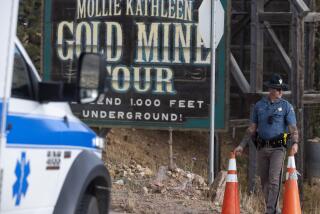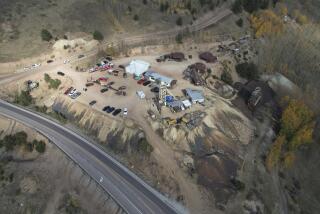S. African Mine Tragedy Kills 100 : Disaster: Underground train jumps tracks and plunges down shaft, crushing crowded elevator.
- Share via
JOHANNESBURG, South Africa — More than 100 mine workers were crushed to death when a 12-ton underground train engine and carriage plunged down a vertical mine shaft and pulverized their crowded elevator, officials said Thursday.
Officials at the Vaal Reefs Mine, one of this country’s richest gold mines, announced that no survivors were found when rescue workers reached the twisted metal and mangled bodies almost 1 1/2 miles underground.
The two-tiered elevator cage was packed with workers changing shifts about 10:30 p.m. Wednesday when the empty locomotive and car apparently jumped the track in a connecting tunnel and tumbled into Shaft Two, falling several hundred feet before crashing into the elevator and snapping its cable.
The massive train and wire-mesh elevator then plummeted the last 1,650 terrifying feet--almost a third of a mile--before smashing into the rocky bottom.
“Pieces of flesh were scattered all over . . . as a two-floor mining (elevator) was crushed into a one-floor tin box,” James Motlatsi, president of the National Union of Mine Workers, grimly told reporters.
The falling train also hit a second, smaller cage used for inspections, but the occupants managed to escape. About 400 other miners underground at the time were also brought to safety.
Of the 106 miners missing and presumed dead, only the remains of six bodies had been recovered by Thursday night. Armed with black body bags and drills, rescue teams and medics steadily worked their way down parallel shafts and miles of lateral tunnels to reach the grisly wreckage.
“The job is now to begin recovering the bodies and bringing them to the surface,” said James Duncan, spokesman for the mine’s owner, Anglo American Corp. He said it may take three days to retrieve all the remains.
Officials said human error was to blame for the tragedy. The engineer either jumped from the moving train or was not in it, as he survived and was under sedation late Thursday in a mine hospital.
The engineer “is suffering from shock and has been unable to tell us what went wrong,” said Dick Fisher, regional general manager at the mine.
He said the locomotive had entered the wrong tunnel and crashed through steel barriers intended to stop smaller machinery.
Roelof F. (Pik) Botha, minister of energy and mineral affairs, said a government investigation into the disaster had already begun.
He said he supported demands by labor leaders for an independent probe and a strict review of mine safety standards.
The locomotive and passenger car are normally used to ferry men, equipment and ore along the maze of dark tunnels to and from working gold-bearing faces. Small elevators carry them to other levels deep within the earth.
All day Thursday, dozens of anxious co-workers in grimy overalls and yellow helmets crowded behind a cordon near the elevator tower at the dusty mine entrance, waiting for news and hoping for survivors. The only news came as weary men hauled stretchers by with body bags.
President Nelson Mandela declared a national day of mourning next week and expressed condolences for the victims’ families.
Vaal Reefs is one of the country’s most productive mines. Last year it yielded more than 155,000 pounds of gold and revenue of $845 million, the company said. It is near the small town of Orkney, about 110 miles southwest of Johannesburg.
The discovery of the world’s largest known gold deposits in the rich strata stretching from Johannesburg transformed the country from an agrarian backwater to Africa’s richest and most powerful economy. Gold has formed the heart of the nation’s economy, as well as its racially tortured past.
*
Over the years, millions of blacks have worked in the white-owned mines, and about 69,000 have died within them, according to the mine workers union.
Miners’ wages start at about $125 a month and rarely rise above $500. Miners are overwhelmingly black, unskilled and illiterate. Most live in cramped, all-male dormitories far from their families.
The mining towns became models for the architects of apartheid, who wanted to separate the races but provide cheap workers for whites.
Although apartheid ended with last year’s democratic elections, most mine managers are white, and union officials say changing rooms, toilets and even elevators are often still unofficially segregated.
More to Read
Sign up for Essential California
The most important California stories and recommendations in your inbox every morning.
You may occasionally receive promotional content from the Los Angeles Times.











